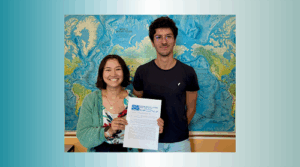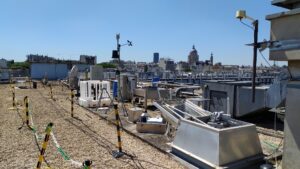Soutenance de thèse
Stanley Nmor
LSCE
Event-driven numerical modelling of early diagenesis in coastal ecosystems: application to flood deposits in Rhône River prodelta
Résumé
The main purpose of this work is to study the biogeochemical response of coastal seafloor subject to episodic massive sediment deposition from floods events. The Rhône River and its connected coastal margins serve as a case-study site for quantifying the impact of these extreme events on early diagenetic processes because it receives significant inputs of sediment (estimated to be up to 80%) during short and intense events. These extreme events are rare and unpredictable, thus the assessment of their impact on sediment biogeochemical processes is difficult.
In order to study the short and intermediate terms response of the sediment biogeochemistry under these abruptly changing conditions, an event-driven numerical model of early diagenesis was specifically developed during this thesis. Using published data of two contrasting floods in year 2008, the model showed reliable capability to simulate the changes induced by the sediment input on the porewater profiles for various solutes. The model suggests that these floods could produce differing biogeochemical response, the extent of which is determined by the underlying characteristics of the flood layer deposit. We found a two-fold increase in overall mineralization rates during the 2008 spring flood event from pre-flood conditions in the spring, which increased further in the fall when a very labile carbon enriched sediment was deposited. My research demonstrated that these differences were due to the nature of organic carbon delivered to Rhone delta as well as the scale (thickness) of deposition.
These intrinsic characteristics might also be responsible for constraining the relaxation timescale of the various porewater solutes (e.g oxygen, dissolved inorganic carbon, sulfate) to a few months as observed in the field. Furthermore, this research also demonstrated that the strong internal cycling and the role of secondary redox processes such as pyrite precipitation (which were enhanced during these flood events) might be responsible for the maintenance of non-sulfidic condition observed in Rhône prodelta sediment. The thesis also briefly explores the concept of ”memory effect” of temporally connected flood depositions. Multiple occurrence of these events can also trigger temporal interaction between floods which has a substantial effect on the processes operating in the deep (such as methanogenesis and sulfate reduction) but negligible for superficial oxic and suboxic processes. This has significant ramification in future scenarios of increasing frequency of these extreme events.
More recent time series of porewater composition obtained during winter campaigns in 2021-22 investigates the temporal evolution of the porewater following an estimated 25 cm of sediment deposition. A remarkable modification of the dissolved inorganic carbon, sulfate and dissolved methane profiles were observed which was distinguishable from the pre-flood situation. Model simulations describes adequately the dataset and showed that these winter events can result to as much as 75% increase in total carbon mineralization, thus enhancing longer-term DIC production in the sediment. This winter flood also leads to a decoupling of the two pathways for sulfate reduction – organoclastic sulfate reduction and anaerobic oxidation of methane and is associated to vertical displacement of the sulfate-methane transition zone. This observation has important implications since further deepening of the AOM maximum zone due to flood deposition could enhance the effective trapping of methane (a ”green house” gas crucial in the context of climate change).
Overall, the numerical exploration in this thesis provides for the first time, a synthesis of the role of episodic event such as the massive flood deposition on spatio-temporal dynamics of the biogeochemical processes in the sediment.
Informations supplémentaires
Lieu
Laboratoire des Sciences du Climat et de l’Environnement
CEA-Orme des Merisiers – 91191 Gif-sur-Yvette cedex (France)
Bâtiment 714, salle 1129
Visio
https://u-paris.zoom.us/j/86393553660?pwd=cXYyTnROMitVZ1QyalR3dTNVbXJwQT09
Composition du jury
- Sandra Arndt, Département Environnement, Géosciences et Société, Université Libre de Bruxelles, rapportrice
- Anniet Laverman, UMR 6553 CNRS ECOBIO, Université de Rennes, rapportrice
- Didier Roche, UMR CNRS 8212 LSCE, Université Paris-Saclay, examinateur
- Bruno Deflandre, UMR CNRS 5805 EPOC – OASU, Université de Bordeaux, examinateur
- Olivier Sulpis, UMR7330 CNRS CEREGE Université d’Aix-Marseille examinateur
- Eric Viollier, UMR CNRS 8212 LSCE, Université Paris Cité, co-directeur de thèse
- Christophe Rabouille, UMR CNRS 8212 LSCE, Université Paris-Saclay, directeur de thèse






